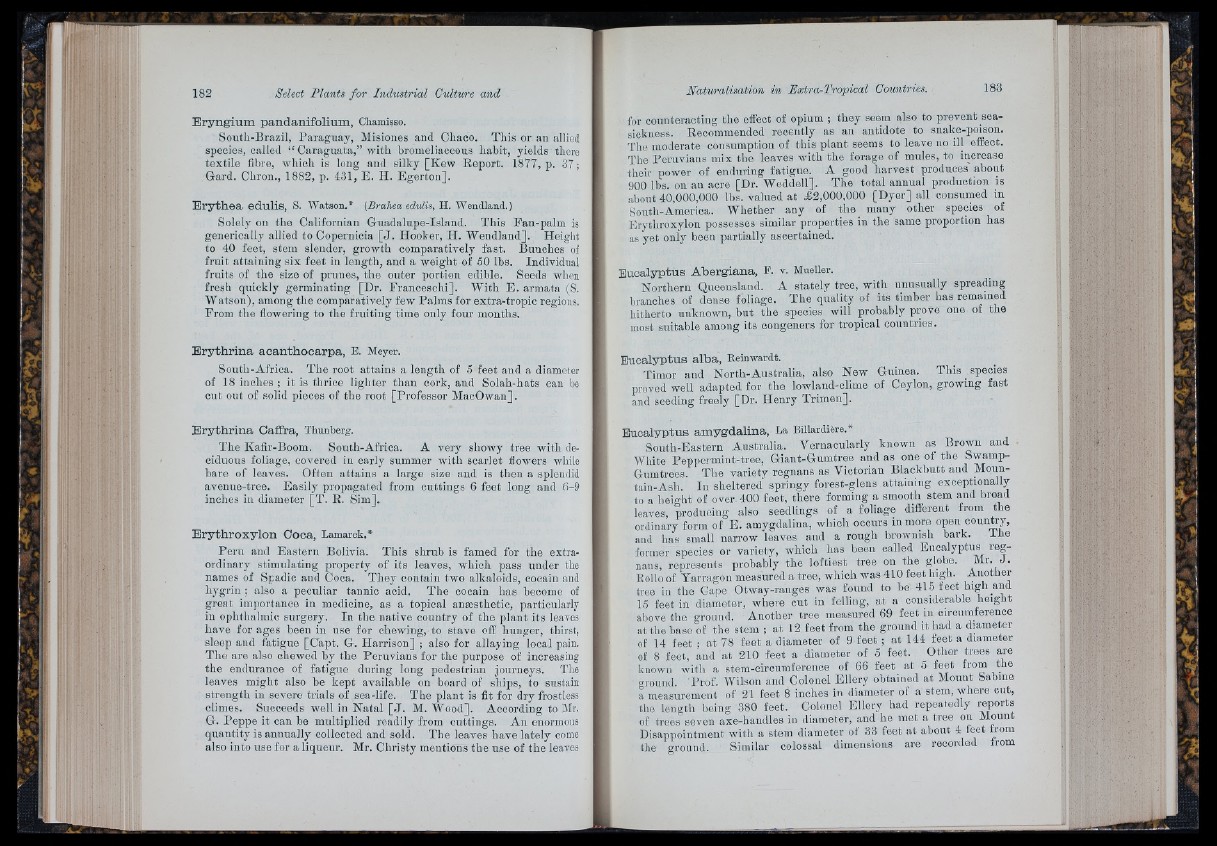
G.- •
! Uili
• !•
'I'i
E r y n g iu m p a n d a n i f o liu m , Chamisso.
South-Brazil, Paraguay, Misiones and Chaco. This or an allied
species, called “ Caraguata,” with bromeliaceous habit, yields there
textile fibre, which is long and silky [Kew Eeport. 1877, p. 37;
Gard. Chron., 1882, p. 431, E. H. Egerton].
E r y t h e a e d u lis , S. Watson. * (Brahea edulis, H. Wendland.)
Solely on the Californian Guadalnpe-Island. This Pan-palm is
generically allied to Copernicia [ J . Hooker, H. Wendland]. Height
to 40 feet, stem slender, growth comparatively fast. Bunches of
fruit attaining six feet iu length, and a weight of 50 lbs. Individual
fruits of the size of prnnes, the outer portion edible. Seeds wlien
fresh quickly germinating [Dr. Francesohi]. With E. armata (S.
Watson), among the comparatively few Palms for extra-tropic regions.
From the flowering to the fruiting time only four months.
E r y t h r i n a a c a n th o o a r p a , E. Meyer.
South-Africa. The root attains a length of 5 feet and a diameter
of 18 inches ; it is thrice lighter than cork, and Solah-hats can be
cut out of solid pieces of the root [Professor MacOwan].
E r y t h r i n a C a ffra , Thunberg.
The Kafir-Boom. Sontli-Africa. A very showy tree with deciduous
foliage, covered in early summer with scarlet flowers while
bare of leaves. Often attains a large size and is then a splendid
avenue-tree. Easily propagated from cuttings 6 feet long and 6-9
inches in diameter [T . R. Sim].
E r y th r o x y l o n C o c a, Lamarck.*
Pern and Eastern Bolivia. This shrub is famed for the extraordinary
stimulating property of its leaves, which pass under the
names of Spadio and Coca. They contain two alkaloids, eocain and
hygrin ; also a peculiar tannio acid. The cocain has become of
great importance in medicine, as a topical anaesthetic, particularly
in ophthalmic surgery. In tlie native country of the plant its leaves
have for ages been in use for chewing, to stave off hunger, thirst,
sleep and fatigue [Capt. G. Harrison] ; also for allaying local pain.
The are also chewed by the Peruvians for the purpose of increasing
the endurance of fatigue during long pedestrian journeys. The
leaves might also be kept available on board of ships, to sustain
strength in severe trials of sea-life. The plant is fit for dry frostless
climes. Succeeds well in Natal [ J . M. Wood]. According to Mr.
G. Peppe it can be multiplied readily from cuttings. An enormous
quantity is annually collected and sold. The leaves have lately como
also into use for a liqueur. Mr. Christy mentions the use of the leaves
for counteracting the effect of opium ; they seem also to prevent seasickness.
Recommended recently as an antidote to snake-poison.
The moderate consumption of this plant seems to leave no ill effect.
The Peruvians mix the leaves with the forage of mules, to increase
their power of enduring fatigue. A good harvest produces about
900 lbs. oil an acre [Dr. Weddell]. The total annual production is
about 40,000,000 lbs. valued a t £2,000,000 [Dyer] all consumed in
South-America. Wliether any of the many other species of
Erythroxylon possesses similar properties in the same proportion has
as yet only been partially ascertained.
E u c a ly p tu s A b e r g ia n a , E. v. Mueller.
Northern Queensland. A stately tree, with unusually spreading
branches of dense foliage. The quality of its timber has remained
hitherto unknown, but the species will probably prove one of the
most suitable among its congeners for tropical countries.
E u c a ly p tu s a lb a , Reinwardt.
Timor and North-Australia, also New Guinea. This species
proved well adapted for the lowland-clime of Ceylon, growing fast
and seeding freely [Dr. Henry Trimen].
E u c a ly p tu s am y g d a l in a , La Biliardière.»
South-Eastern Australia. Vernacularly known as Brown and
White Peppermint-tree, Giant-Gumtree and as one oi the Swamp-
Giimtrees. The variety regnans as Victorian Blackbutt and Moun-
tain-Ash. In sheltered springy forest-glens attaining exceptionally
to a height of over 400 feet, there forming a smooth stem and broad
leaves, producing also seedlings of a foliage different from the
ordinary form of E. amygdalina, which occurs in more open countiy,
and has small narrow leaves and a rough brownish bark. The
former species or variety, which lias been called Eiioalyptns regnans,
represents probably the loftiest tree on the globe. Mr. J .
Rollo of Tarragon measured a tree, which was 410 feet high. Another
tree in the Cape Otway-ranges was found to be 415 feet high and
15 feet in diameter, where cut in felling, at a considerable height
above tlie ground. Another tree measured 69 feet in circumference
at the base of the stem ; a t 12 feet from the ground it had a diameter
of 14 feet ; at 78 feet a diameter of 9 feet ; at 144 feet a diameter
of 8 feet, and a t 210 feet a diameter of 5 feet. Other trees are
known witli a stem-circumference of 66 feet at 5 feet from the
ground. Prof. Wilson and Colonel Ellery obtained at Mount Sabine
a measurement of 21 feet 8 inches in diameter of a stem, where cut,
the length being 380 feet. Colonel Ellery had repeatedly reports
of trees seven axe-handles in diameter, and he met a tree on Mount
Disappointment with a stem diameter oi 33 feet at about 4 feet trom
1 1 1 ! _________ t ____ vz-vi-»/-.!’/! iti li f p ^ T Y l the ground. Similar colossal dimensions are recorded irom